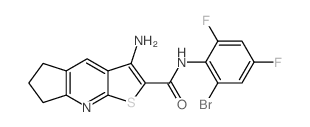| In Vitro |
DC_AC50 exhibits IC50 values of 9.88 μM, 12.57 μM, 5.96 μM and 6.68 μM in Canine Abrams, Canine D1, human HOS and human MG63) cells, respectively[1]. DC_AC50 (0-10 μM)-treated cells are significantly less mitotically active, as demonstrated by decreased expression of phospho-histone H3 and cell cycle analysis[1]. DC_AC50 (10 μM) potentiates carboplatin-induced apoptosis in OSA cells and decreasesclonogenic survival[1]. DC_AC50 induces cell cycle arrest at both the 3 and 10 μM doses and DC_AC50 induces increase S phase cells dose-independently[1]. DC_AC50 (3 μM) inhibits the migration and of canine and human OSA cells[1]. DC_AC50 (2.5-10 μM) is highly efficient at inhibiting cancer cell proliferation (human lung cancer H1299 cells, leukaemia cancer K562 cells, breast cancer MDA-MB-231 cells and head and neck cancer 212LN cells) in a dose-dependent manner. DC_AC50 fails to exhibit any notable inhibition of the cell proliferation of human normal epithelial lung BEAS-2B cells or breast MCF-10A cells as control cells[2]. Cell Viability Assay[1] Cell Line: Canine OSA (Abrams, D1 and human OSA (HOS, MG63) cells. Concentration: 0-10 μM. Incubation Time: 72 h. Result: Dose-dependently decreased viability of OSA cells. Apoptosis Analysis[1] Cell Line: Abrams and HOS cells. Concentration: 1, 3 and 10 μM (10 μM Carboplatin). Incubation Time: 24 h. Result: Potentiated carboplatin-induced apoptosis.
|
